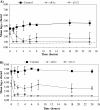In vivo and ex vivo evaluations of bacteriophages e11/2 and e4/1c for use in the control of Escherichia coli O157:H7
- PMID: 20851992
- PMCID: PMC2976219
- DOI: 10.1128/AEM.01530-10
In vivo and ex vivo evaluations of bacteriophages e11/2 and e4/1c for use in the control of Escherichia coli O157:H7
Abstract
This study investigated the effect of bacteriophages (phages) e11/2 and e4/1c against Escherichia coli O157:H7 in an ex vivo rumen model and in cattle in vivo. In the ex vivo rumen model, samples were inoculated with either 10³ or 10⁶ CFU/ml inoculum of E. coli O157:H7 and challenged separately with each bacteriophage. In the presence of phage e11/2, the numbers of E. coli O157:H7 bacteria were significantly (P < 0.05) reduced to below the limit of detection within 1 h. Phage e4/1c significantly (P < 0.05) reduced E. coli O157:H7 numbers within 2 h of incubation, but the number of surviving E. coli O157:H7 bacteria then remained unchanged over a further 22-h incubation period. The ability of a phage cocktail of e11/2 and e4/1c to reduce the fecal shedding of E. coli O157:H7 in experimentally inoculated cattle was then investigated in two cattle trials. Cattle (yearlings, n = 20 for trial one; adult fistulated cattle, n = 2 for trial two) were orally inoculated with 10(10) CFU of E. coli O157:H7. Animals (n = 10 for trial one; n = 1 for trial two) were dosed daily with a bacteriophage cocktail of 10(11) PFU for 3 days postinoculation. E. coli O157:H7 and phage numbers in fecal and/or rumen samples were determined over 7 days postinoculation. E. coli O157:H7 numbers rapidly declined in all animals within 24 to 48 h; however, there was no significant difference (P > 0.05) between the numbers of E. coli O157:H7 bacteria shed by the phage-treated or control animals. Phages were recovered from the rumen but not from the feces of the adult fistulated animal in trial two but were recovered from the feces of the yearling animals in trial one. While the results from the rumen model suggest that phages are effective in the rumen, further research is required to improve the antimicrobial effectiveness of phages for the elimination of E. coli O157:H7 in vivo.
Figures



Similar articles
-
Bacteriophage isolated from feedlot cattle can reduce Escherichia coli O157:H7 populations in ruminant gastrointestinal tracts.Foodborne Pathog Dis. 2008 Apr;5(2):183-91. doi: 10.1089/fpd.2007.0057. Foodborne Pathog Dis. 2008. PMID: 18407757
-
Assessment of Escherichia coli O157:H7-specific bacteriophages e11/2 and e4/1c in model broth and hide environments.Int J Food Microbiol. 2011 Jun 30;147(3):188-94. doi: 10.1016/j.ijfoodmicro.2011.04.001. Epub 2011 Apr 13. Int J Food Microbiol. 2011. PMID: 21531032
-
Evaluation of a cocktail of three bacteriophages for biocontrol of Escherichia coli O157:H7.Appl Environ Microbiol. 2004 Jun;70(6):3417-24. doi: 10.1128/AEM.70.6.3417-3424.2004. Appl Environ Microbiol. 2004. PMID: 15184139 Free PMC article.
-
Use of Bacteriophages to Control Escherichia coli O157:H7 in Domestic Ruminants, Meat Products, and Fruits and Vegetables.Foodborne Pathog Dis. 2017 Sep;14(9):483-493. doi: 10.1089/fpd.2016.2266. Epub 2017 Jun 21. Foodborne Pathog Dis. 2017. PMID: 28636835 Review.
-
Perspectives on super-shedding of Escherichia coli O157:H7 by cattle.Foodborne Pathog Dis. 2015 Feb;12(2):89-103. doi: 10.1089/fpd.2014.1829. Epub 2014 Dec 16. Foodborne Pathog Dis. 2015. PMID: 25514549 Review.
Cited by
-
Approaches to treatment of emerging Shiga toxin-producing Escherichia coli infections highlighting the O104:H4 serotype.Front Cell Infect Microbiol. 2015 Mar 18;5:24. doi: 10.3389/fcimb.2015.00024. eCollection 2015. Front Cell Infect Microbiol. 2015. PMID: 25853096 Free PMC article. Review.
-
Safety Properties of Escherichia coli O157:H7 Specific Bacteriophages: Recent Advances for Food Safety.Foods. 2023 Oct 31;12(21):3989. doi: 10.3390/foods12213989. Foods. 2023. PMID: 37959107 Free PMC article. Review.
-
Bacteriophages for the Targeted Control of Foodborne Pathogens.Foods. 2023 Jul 18;12(14):2734. doi: 10.3390/foods12142734. Foods. 2023. PMID: 37509826 Free PMC article. Review.
-
Genomic, proteomic and physiological characterization of a T5-like bacteriophage for control of Shiga toxin-producing Escherichia coli O157:H7.PLoS One. 2012;7(4):e34585. doi: 10.1371/journal.pone.0034585. Epub 2012 Apr 13. PLoS One. 2012. PMID: 22514640 Free PMC article.
-
The Combination of Phages and Faecal Microbiota Transplantation Can Effectively Treat Mouse Colitis Caused by Salmonella enterica Serovar Typhimurium.Front Microbiol. 2022 Jul 7;13:944495. doi: 10.3389/fmicb.2022.944495. eCollection 2022. Front Microbiol. 2022. PMID: 35875536 Free PMC article.
References
-
- Abedon, S. T. 2009. Kinetics of phage-mediated biocontrol of bacteria. Foodborne Pathog. Dis. 6:807-815. - PubMed
-
- Alisky, J., K. Iczkowski, A. Rapoport, and N. Troitsky. 1998. Bacteriophages show promise as antimicrobial agents. J. Infect. 36:5-15. - PubMed
-
- Arthur, T. M., J. E. Keen, J. M. Bosilevac, D. M. Brichta-Harhay, N. Kalchayanand, S. D. Shackelford, T. L. Wheeler, X. W. Nou, and M. Koohmaraie. 2009. Longitudinal study of Escherichia coli O157:H7 in a beef cattle feedlot and role of high-level shedders in hide contamination. Appl. Environ. Microbiol. 75:6515-6523. - PMC - PubMed
-
- Bach, S. J., R. P. Johnson, K. Stanford, and T. A. McAllister. 2009. Bacteriophages reduce Escherichia coli O157:H7 levels in experimentally inoculated sheep. Can. J. Anim. Sci. 89:285-293.
-
- Bach, S. J., T. A. McAllister, D. M. Veira, V. P. J. Gannon, and R. A. Holley. 2003. Effect of bacteriophage DC22 on Escherichia coli O157:H7 in an artificial rumen system (Rusitec) and inoculated sheep. Anim. Res. 52:89-101.
Publication types
MeSH terms
LinkOut - more resources
Full Text Sources
Other Literature Sources
Molecular Biology Databases

